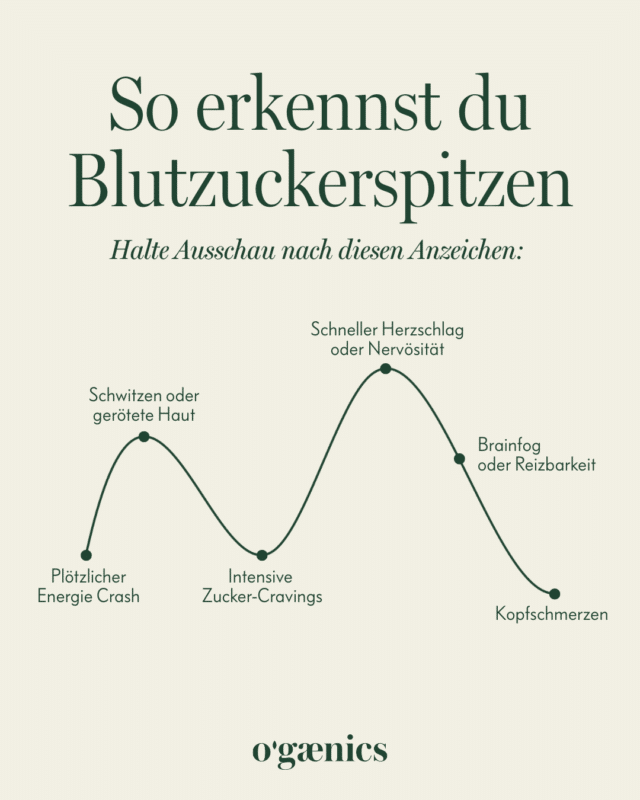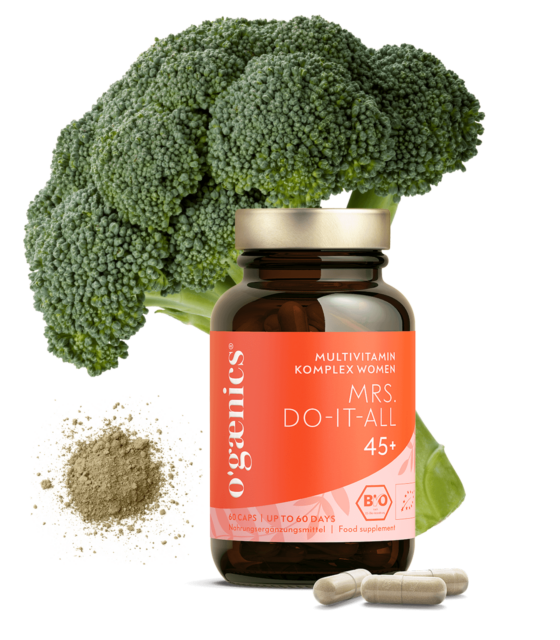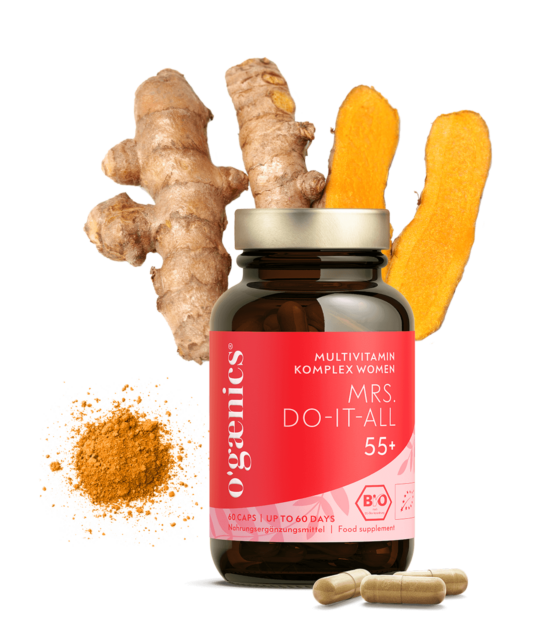IN THIS ARTICLE
Why stable blood sugar is the key to fat burning how you achieve it.
What is the blood sugar?
Blood sugar, also called glucose, is our main source of energy. It determines how hungry and energetic we feel. It is formed during the breakdown of carbohydrates. We are at our best when our blood sugar is always constantly at the same level, not too high and not too low – in other words, in balance. Only then the fat burning in your body will work.
Glucose metabolism is a complex process in the human body that involves the uptake, storage and utilization of glucose to provide energy for cells. The liver plays a decisive role in this. It stores glucose in the form of glycogen, releases glucose into the blood to ensure energy supply and contributes to glucose production when glycogen stores are depleted.
These processes are crucial for supplying the body with energy and regulating blood sugar levels. If your liver is weakened and cannot function optimally, your blood sugar level cannot be regulated. You can read how to recognize a weakened liver and what you can do about it in our article “Tired all the time? Maybe your liver is whispering for help”.
The blood sugar roller coaster

The infographic clearly shows how the consumption of large amounts of simple carbohydrates leads to a rapid increase in blood sugar levels and subsequent insulin reactions. This takes place in three phases:
- Glucose spike: The consumption of simple carbohydrates causes a rapid rise in blood sugar. This leads to a correspondingly high release of insulin, a hormone that helps to transport sugar from the blood into the cells.
- Insulin action: Insulin has several effects. It blocks the breakdown and burning of fat and instead promotes fat storage. This can lead to weight gain and metabolic problems in the long term.
- Glucose crash: After the sugar has been quickly removed from the blood thanks to insulin, a sharp drop in blood sugar often follows. This condition is called a “glucose crash” and can trigger cravings for even more carbohydrates, leading to a cyclical pattern of highs and lows in blood sugar levels.
The picture of a normal blood glucose level is represented by a dashed line, which shows a less dramatic fluctuation and is therefore considered healthier. A balanced diet with complex carbohydrates and less sugar results in a more stable energy supply and promotes better health.
How does an unbalanced blood glucose level manifest itself?

An unbalanced blood glucose level can manifest itself in a number of ways and often depends on the degree of deviation and the duration of the imbalance. Here are some possible symptoms of unbalanced blood sugar:
Low blood sugar (hypoglycemia):
- You feel tired or weak
- You have sweats
- You have palpitations or an increased pulse rate
- You are nervous or have anxiety
- You have ravenous appetite
- You are confused or irritable
- You have vision problems
- You have a headache
High blood sugar (hyperglycemia):
- You have to go to the bathroom often
- You have strong thirst
- You feel tired or weak
- You have vision problems
- Mouth and skin are dry
- You have no appetite
- You suffer from nausea or vomiting
- You have stomach ache
Constantly unbalanced blood sugar can lead to serious problems in the long term, especially for people with diabetes. But blood sugar levels are especially important whenever you want to boost your fat burning. This is only possible if the blood sugar is stable and balanced.
The right diet can help you stabilize your blood sugar naturally, allowing you to burn more fat and have consistent energy throughout the day.
Lose weight: blood sugar plays an important role
When your blood sugar level spikes from eating sugar or other carbohydrates, the pancreas releases the hormone insulin to regulate blood sugar.
Insulin takes up blood sugar and transports it from the blood into the cells. This balances out the excessively high blood glucose level. This insulin output tells our body that there is plenty of energy available and that it should stop burning fat now. Instead, your body then begins to store fat.
So insulin lowers your blood sugar, but at the same time inhibits fat burning. Due to hormonal counter-regulation, extreme fluctuations in blood glucose levels also promote cravings.
As a result, the ups and downs of blood sugar start all over again. This is also called the “blood sugar roller coaster.”
Nerd Info: The normal range for your blood glucose should be between 80 mg/ml and 120 mg/ml
Chromium and magnesium support stable blood sugar
Chromium is an essential trace element involved in carbohydrate and fat metabolism and also supports balanced blood sugar levels. The best sources of chromium in our latitudes are, for example, quinces, brown rice, Brazil nuts, oysters and pears.
Dietary supplements can also support your chromium supply. In Ogaenics, chromium from a plant source is included in all multivitamins for blood sugar stabilization, e.g. in Mrs. Do-It-All Multivitamin Complex Women 45+. It contains natural chromium from organic plants, herbs and fruits to help stabilize your blood sugar and thus optimize your fat burning.
Magnesium has also been shown to help balance blood sugar. In studies, it reduced insulin resistance and stabilized blood sugar. Thus, it indirectly supports your fat burning. When choosing a magnesium supplement, make sure to choose a natural magnesium, as it is absorbed in the body almost 100 times better than the synthetic magnesium oxide. You’ll find natural magnesium from the green algae Ulva lactuca in organic quality in Calm-A-Lama plant-based magnesium from Ogaenics.
Dietary rules for stable blood sugar
But what does our blood sugar have to do with losing weight now? Losing weight happens between meals – when you have a balanced blood sugar level and there is no excess insulin. For this reason, you can facilitate your healthy fat burning and keep your metabolism active in the long run with a balanced blood sugar.
1. always eat the vegetables first
To stabilize blood sugar, it is advisable to eat vegetables first at a meal, followed by proteins and fats, and carbohydrates last. This sequence has several advantages: If proteins are consumed before carbohydrates, the carbohydrates enter the bloodstream more slowly, which avoids high blood sugar peaks. The fiber in vegetables also supports this process. In addition, vegetables and proteins make you feel fuller before you eat the carbohydrates, which often means that you eat fewer carbohydrates than planned.
2. prefer complex carbohydrates
To keep your blood sugar level as constant as possible and to boost fat burning, you should avoid simple carbohydrates and hidden sugars in foods as much as possible and instead rely on complex carbohydrates. It is worth taking a look at the ingredient lists.
The simple carbohydrates you should avoid include all types of sugars that end in “ose” in the ingredient list of foods, for example sucrose (=household sugar), fructose (=fructose), lactose (=milk sugar) and glucose.
Instead, choose the whole-grain variety of bread, pasta and rice as often as possible.
3. do not skip a meal
Never starve your body by skipping a meal. This causes the production of stress hormones such as cortisol, which prevent you from burning fat. The low blood sugar resulting from hunger also causes your body to break down muscle, which slows down your metabolism. So that makes no sense.
4. eat only every 4 hours
It’s not just what you eat that matters, but when you eat it. The best way to maintain a balanced blood sugar level is to take a regular 4-hour break between meals. And nothing to eat in between. Snacking is the end of all fat burning.
By eating regular meals, you’ll balance your blood sugar and support your weight loss. Start your first meal one hour after waking up and eat a balanced meal every four hours – until you put your head on the pillow in the evening.
If you don’t skip a meal, your metabolism will increase and your blood sugar levels will remain stable. The result: the insulin content in the blood is lowered and fat burning runs at full speed.
5. pay attention to a low glycemic index
If you are very sensitive to sugar, then you should pay special attention to foods with a low glycemic index in your diet. This way you can keep your blood sugar stable.
The glycemic index is a measure used to determine the effect of a food on blood glucose. The lower it is, the better for your blood sugar. Basically, only foods that contain carbohydrates can have a glycemic index.
Low glycemic index foods, along with fats and proteins, stabilize your blood sugar levels, helping you burn fat.
6. move after eating
Also, support your body after eating by moving. The energy from the carbohydrates is thus used for combustion and not stored as a fat reserve. So try to always get exercise after eating, for example, by taking a healthy walk in the fresh air. This supports your fat burning.
7. reduce stress
The stress hormone cortisol is closely linked to elevated blood glucose. Its release is positively influenced by exercise, sleep and relaxation techniques. Reading, bathing and spending time in nature can also help lower your stress.
In addition, so-called adaptogenic herbs like ashwagandha help your body reduce stress hormones in the body during periods of stress. This brings body, mind and soul back into balance. Can be found in the Ogaenics Adapto Balance Fatigue Complex.
To learn how to lower your stress hormones, check out the article “Lowering Cortisol: How to Beat Stress and Fatigue.”
Conclusion
Stable blood sugar is essential for weight loss and overall health. It not only helps burn fat, but also helps maintain energy throughout the day and prevent serious health problems in the long run. Through conscious nutrition and a healthy lifestyle, you can keep your blood sugar stable throughout the day while activating your metabolism and fat burning.
The best supplements for your blood sugar control
-
Bestseller
Calm A Lama
Plant-based organic magnesium from premium organic green algae extract for muscles and nerves44,90 €1.076,74 € / kg
-
Bestseller
Mr Do-It-All 18+
Organic Multivitamin Complex Premium for men between 18 and 44, All-In-One79,90 €2.069,95 € / kg
-
Bestseller
Mr Do-It-All 45+
Organic Multivitamin Complex Premium for men aged 45 and over, All-In-One79,90 €2.048,72 € / kg
-
Bestseller
Mrs Do-It-All 18+
Organic Multivitamin Complex Premium for women of fertile age, All-In-One!79,90 €2.302,59 € / kg
-
Bestseller
Mrs Do-It-All 45+
Organic Multivitamin Complex Premium for menopausal women, All-In-One!79,90 €1.997,50 € / kg
-
Bestseller
Mrs Do-It-All 55+
Organic Multivitamin Complex Premium for women after the menopause, All-In-One!79,90 €1.997,50 € / kg
-
Mrs Do-It-All 65+
Organic Multivitamin Complex Premium from vitamin A to zinc for women aged 65 and over, All-In-One!79,90 €2.091,62 € / kg



















 No products in the cart.
No products in the cart.